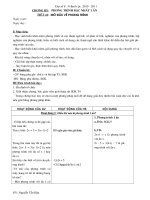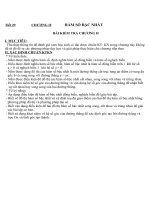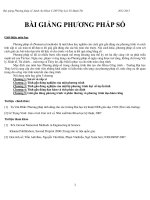Bai giang kmaps đai so boolean
Bạn đang xem bản rút gọn của tài liệu. Xem và tải ngay bản đầy đủ của tài liệu tại đây (1.05 MB, 28 trang )
K-maps
Minimization of Boolean expressions
• The minimization will result in reduction of the number of gates
(resulting from less number of terms) and the number of inputs
per gate (resulting from less number of variables per term)
• The minimization will reduce cost, efficiency and power
consumption.
• y(x+x`)=y.1=y
• y+xx`=y+0=y
• (x`y+xy`)=xy
• (x`y`+xy)=(xy)`
Minimum SOP and POS
• The minimum sum of products (MSOP) of a function, f, is a SOP
representation of f that contains the fewest number of product
terms and fewest number of literals of any SOP representation of f.
Minimum SOP and POS
• f= (xyz +x`yz+ xy`z+ …..)
Is called sum of products.
The + is sum operator which is an OR gate.
The product such as xy is an AND gate for the two inputs x and y.
Example
• Minimize the following Boolean function using
sum of products (SOP):
• f(a,b,c,d) = m(3,7,11,12,13,14,15)
abcd
3 0011
7 0111
11 1011
12 1100
13 1101
14 1110
15 1111
a`b`cd
a`bcd
ab`cd
abc`d`
abc`d
abcd`
abcd
Example
f(a,b,c,d) = m(3,7,11,12,13,14,15)
=a`b`cd + a`bcd + ab`cd + abc`d`+ abc`d + abcd` + abcd
=cd(a`b` + a`b + ab`) + ab(c`d` + c`d + cd` + cd )
=cd(a`[b` + b] + ab`) + ab(c`[d` + d] + c[d` + d])
=cd(a`[1] + ab`) + ab(c`[1] + c[1])
=ab+ab`cd + a`cd
=ab+cd(ab` + a`)
=ab+ cd(a + a`)(a`+b`)
= ab + a`cd + b`cd
= ab +cd(a` + b`)
Minimum product of sums (MPOS)
• The minimum product of sums (MPOS) of a function, f, is a POS
representation of f that contains the fewest number of sum terms and
the fewest number of literals of any POS representation of f.
• The zeros are considered exactly the same as ones in the case of sum
of product (SOP)
Example
f(a,b,c,d) = M(0,1,2,4,5,6,8,9,10)
=m(3,7,11,12,13,14,15)
=[(a+b+c+d)(a+b+c+d`)(a+b`+c`+d`)
(a`+b+c`+d`)(a`+b`+c+ d)(a`+b`+c+ d`) (a`+b`+c`+d)(a`+b`+c`+d`)]
Karnaugh Maps (K-maps)
• Karnaugh maps -- A tool for representing Boolean functions of
up to six variables.
• K-maps are tables of rows and columns with entries represent
1`s or 0`s of SOP and POS representations.
Karnaugh Maps (K-maps)
•
An n-variable K-map has 2n cells with each cell
corresponding to an n-variable truth table
value.
•
K-map cells are labeled with the corresponding
truth-table row.
•
K-map cells are arranged such that adjacent
cells correspond to truth rows that differ in
only one bit position (logical adjacency).
Karnaugh Maps (K-maps)
• If mi is a minterm of f, then place a 1 in cell i of the K-map.
• If Mi is a maxterm of f, then place a 0 in cell i.
• If di is a don’t care of f, then place a d or x in cell i.
Examples
• Two variable K-map f(A,B)=m(0,1,3)=A`B`+A`B+AB
1
0
1
1
1
1
B 0
A 0
Three variable map
• f(A,B,C) = m(0,3,5)=
A`B`C`+A`BC+AB`C
A`B` A`B
0 0 0 1
1
C`
0
1C
1
A`BC
A B
1 1
A B`
1 0
A`B`C`
1
AB`C
Maxterm example
(A+B) (A+B`) (A`+B`) (A`+B)
A`B` A`B
AB
AB`
C
0
C`
C` C
0
0
0
0
f(A,B,C) = M(1,2,4,6,7)
=(A+B+C`)(A+B`+C)(A`+B+C) )(A`+B`+C) (A`+B`+C`)
Note that the complements are (0,3,5) which are the minterms of
the previous example
Four variable example
(a) Minterm form. (b) Maxterm form.
f(a,b,Q,G) = m(0,3,5,7,10,11,12,13,14,15) = M(1,2,4,6,8,9)
Simplification of Boolean Functions
Using K-maps
• K-map cells that are physically adjacent are also logically
adjacent. Also, cells on an edge of a K-map are logically
adjacent to cells on the opposite edge of the map.
• If two logically adjacent cells both contain logical 1s, the
two cells can be combined to eliminate the variable that
has value 1 in one cell’s label and value 0 in the other.
Simplification of Boolean Functions
Using K-maps
• This is equivalent to the algebraic operation, aP + a P =P
where P is a product term not containing a or a.
• A group of cells can be combined only if all cells in the group
have the same value for some set of variables.
Simplification Guidelines for K-maps
• Always combine as many cells in a group as possible.
This will result in the fewest number of literals in the
term that represents the group.
• Make as few groupings as possible to cover all
minterms. This will result in the fewest product
terms.
• Always begin with the largest group, which means if
you can find eight members group is better than two
four groups and one four group is better than pair of
two-group.
Universal set
A
Example
BC
Simplify f= A`BC`+
A B C`+ A B C using;
(a) Sum of minterms. (b) Maxterms.
C
B
• Each cell of an n-variable K-map has
nABlogically adjacent
(a)
cells.
A
BC
AB
C
00
0
01
11
2
0
6
1
1
10
C
7
C 1
00
4
0
0
1
3
A
AB
5
C 1
11
2
6
10
4
0
1
1
01
0
3
0
7
0
5
0
AB
B
B
(b)
(c)
F`= B`+ A`C
a-
f(A,B,C) = AB + BC
b-
f(A,B,C) = B(A + C)
F = B(A+C`)
Example Simplify
f(A,B,C,D) = m(2,3,4,5,7,8,10,13,15)
A
AB
CD
00
0
01
4
00
1
5
13
11
7
1
2
10
9
15
6
00
00
1
3
11
2
1
1
01
4
00
9
1
D
11
5
3
C
1
13
7
1
2
10
10
8
1
1
11
10
11
12
1
01
1
14
00
0
1
15
10
A
CD
10
1
1
6
14
1
AB
8
13
7
1
6
D
11
1
(b)
1
11
1
(a)
12
5
15
B
1
01
2
9
1
B
01
4
13
7
1
10
1
A
0
10
C
10
10
8
1
1
11
1
CD
5
3
1
AB
C
1
D
11
12
1
01
11
14
01
4
00
1
1
00
0
1
1
3
CD
10
8
1
01
C
11
12
A
AB
15
1
6
9
1
D
11
1
14
1
10
1
B
B
(c)
(d)
Example Multiple selections
f(A,B,C,D) = m(2,3,4,5,7,8,10,13,15)
A
AB
CD
00
0
01
4
00
1
5
13
11
7
1
2
6
0
9
15
1
4
1
D
11
5
3
C
1
1
0
9
1
01
4
1
D
11
5
3
C
1
1
1
15
1
6
9
1
D
11
1
14
1
10
1
B
B
B
(a)
(b)
(c)
c produces less terms than a
10
8
13
7
2
10
12
1
11
10
11
1
01
1
14
00
00
1
1
6
CD
10
1
15
A
AB
8
13
7
2
10
12
1
11
10
11
1
01
1
14
01
00
1
1
00
8
1
1
3
10
12
CD
10
1
01
C
11
A
AB
Example Redundant selections
f(A,B,C,D) = m(0,5,7,8,10,12,14,15)
A
AB
CD
00
0
00
01
4
1
1
5
CD
10
13
0
00
1
9
3
7
15
1
2
6
01
4
1
D
11
14
5
10
1
13
7
2
6
(b)
AB
00
01
4
1
5
13
CD
10
7
11
00
1
9
6
01
4
15
1
D
11
14
1
5
10
1
7
11
C
10
1
10
8
1
13
9
15
11
1
3
1
11
12
1
01
1
2
00
0
1
3
A
AB
8
1
01
C
11
12
1
1
B
A
00
10
1
(a)
0
D
11
1
14
B
CD
9
15
1
10
1
1
1
3
C
10
10
8
1
11
1
11
12
1
01
1
11
00
8
1
01
C
11
12
A
AB
1
2
6
D
1
14
10
10
1
B
B
(c)
(d)
1
Example
Example
Example









